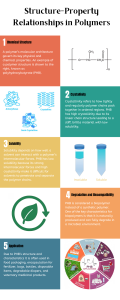Part 5: Structure-property Relationships in Polymers
Why does silk stretch delicately while Kevlar resists bullets? How can a flexible hydrogel mimic muscle tissue, while a plastic bottle remains rigid and transparent? The answer lies not only in what these materials are made of, but in how their molecular structures are arranged. The relationship between a polymer’s internal structure and its properties—known as the structure–property relationship—is one of the most fundamental principles in materials science. Understanding it allows scientists to design materials whose performance can be tuned precisely for their function, from biodegradable packaging films to high-strength fibers and responsive biomedical gels.
Every polymer’s performance begins with its structure. The way atoms connect along the chain, how those chains fold or pack together, and the strength of the interactions between them all shape the material’s behavior. Two materials made of similar elements—such as natural rubber (polyisoprene) and polystyrene—can exhibit completely different properties because of variations in chain flexibility and intermolecular forces. Rubber’s flexible, double-bonded backbone allows it to stretch and recover, while polystyrene’s bulky side groups restrict movement, making it hard and brittle. This simple comparison captures the essence of polymer science: the architecture of a polymer determines its behavior.
In polymer research, this relationship bridges the microscopic world of atoms and bonds with the macroscopic materials that define modern life. When chemists modify chain architecture, crystallinity, or functional groups, they are not merely synthesizing new molecules—they are controlling stiffness, elasticity, solubility, conductivity, transparency, and degradation rate. These parameters decide whether a polymer behaves as a soft hydrogel, a tough fiber, or an electronic conductor. Recognizing these links transforms polymer chemistry from empirical trial-and-error into intentional material design. As industries push toward sustainability and multifunctionality, the ability to predict how molecular-level changes affect bulk performance has become essential.
This topic holds growing significance as the field moves toward sustainable and high-performance materials. Understanding how chemical structure connects to function enables the creation of biodegradable alternatives to petroleum-based plastics and the design of “smart” polymers that respond to temperature, pH, or light. Advances in modeling and characterization now allow scientists to predict and manipulate polymer properties with remarkable precision—turning structure–property relationships from a descriptive science into a predictive and design-driven discipline.
This section explores polymers from several perspectives to show how structure shapes performance across diverse systems. It begins with biopolymers, where natural organization gives rise to strength, flexibility, and biodegradability, demonstrating how hierarchical structures in nature inspire sustainable material design. The next topic, hydrophilicity and hydrophobicity, explains how chemical polarity and surface chemistry control water interaction, affecting wettability, adhesion, and compatibility in coatings and biomedical materials. Polymeric fluorescent probes highlight how conjugation length and side-chain design tune light absorption and emission, connecting molecular structure to optical performance. Doped conjugated polymers build on this idea by showing how electronic structure and controlled doping modify conductivity and optical response, critical for flexible and wearable electronics. Finally, hydrogel mechanics links network architecture to elasticity and durability, illustrating how crosslinking density and water content allow hydrogels to transition from soft, tissue-like materials to robust structural supports.
Together, these chapters reveal a unifying truth: structure defines function. By understanding how molecular features govern physical and chemical behavior, polymer scientists can design materials—whether scaffolds, coatings, or conductive films—with intent rather than reliance on experimentation alone. The structure–property framework is not just a scientific concept; it is a mindset that connects chemistry, physics, and engineering into purposeful material innovation.
Upon completing this section, readers will be able to:
- Explain how a polymer’s chemical structure and molecular architecture—such as crystallinity, chain stiffness, and intermolecular interactions—govern its physical and chemical properties.
- Compare and contrast the structure–property relationships of natural biopolymers with those of synthetic polymers, recognizing how their molecular origins lead to differences in function and degradation pathways.
- Correlate specific structural features of advanced functional polymers—such as hydrogels, conductive polymers, and fluorophores—to their unique performance in specialized applications.
- Apply structure–property principles to predict polymer performance or propose rational designs to meet specific material requirements.

